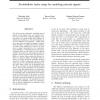Free Online Productivity Tools
i2Speak
i2Symbol
i2OCR
iTex2Img
iWeb2Print
iWeb2Shot
i2Type
iPdf2Split
iPdf2Merge
i2Bopomofo
i2Arabic
i2Style
i2Image
i2PDF
iLatex2Rtf
Sci2ools
UAI
2004
2004
Probabilistic Index Maps for Modeling Natural Signals
One of the major problems in modeling natural signals is that signals with very similar structure may locally have completely different measurements, e.g., images taken under different illumination conditions, or the speech signal captured in different environments. While there have been many successful attempts to address these problems in application-specific settings, we believe that underlying a large set of problems in signal representation is a representational deficiency of intensity-derived local measurements that are the basis of most efficient models. We argue that interesting structure in signals is better captured when the signal is defined as a matrix whose entries are discrete indices to a separate palette of possible measurements. In order to model the variability in signal structure, we define a signal class not by a single index map, but by a probability distribution over the index maps, which can be estimated from the data, and which we call probabilistic index maps....
Related Content
| Added | 31 Oct 2010 |
| Updated | 31 Oct 2010 |
| Type | Conference |
| Year | 2004 |
| Where | UAI |
| Authors | Nebojsa Jojic, Yaron Caspi, Manuel Reyes-Gomez |
Comments (0)

